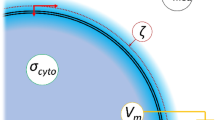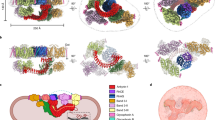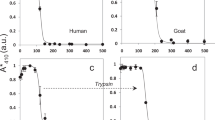Abstract
AN investigation of the calcium–potassium uptake of human erythrocyte ghosts demonstrated that their behaviour was qualitatively the same as a phospholipid-eholestcrol membrane model1. The membrane model's behaviour can be explained by the presence of negative fixed charge due to a particular phospholipid, phosphatidyl sorine2. Fragmented human erythrocyte ghosts behave as if they also possess negative fixed charge due to some chemical component or components. The work recorded here extends the analysis of the cation exchange properties of ghost fragments to the equilibrium between sodium and potassium at two concentrations of total salt.
This is a preview of subscription content, access via your institution
Access options
Subscribe to this journal
Receive 51 print issues and online access
$199.00 per year
only $3.90 per issue
Buy this article
- Purchase on Springer Link
- Instant access to full article PDF
Prices may be subject to local taxes which are calculated during checkout
Similar content being viewed by others
References
Mikulecky, D. C., and Tobias, J. M., J. Cell and Comp. Physiol., 64, 151 (1964).
Nash, H. A., and Tobias, J. M., Proc. U.S. Nat. Acad. Sci., 51, 476 (1964).
Sanui, H., and Pace, N., J. Cell. and Comp. Physiol., 62, 95 (1963).
Author information
Authors and Affiliations
Rights and permissions
About this article
Cite this article
MIKULECKY, D. Sodium - Potassium Ion Exchange Equilibria for Fragmented Human Erythrocyte Ghosts. Nature 205, 706–707 (1965). https://doi.org/10.1038/205706a0
Published:
Issue Date:
DOI: https://doi.org/10.1038/205706a0
Comments
By submitting a comment you agree to abide by our Terms and Community Guidelines. If you find something abusive or that does not comply with our terms or guidelines please flag it as inappropriate.



